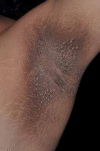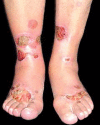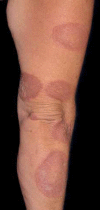Diabetes mellitus and the skin
- PMID: 28225950
- PMCID: PMC5312172
- DOI: 10.1590/abd1806-4841.20175514
Diabetes mellitus and the skin
Abstract
Several dermatoses are routinely associated with diabetes mellitus, especially in patients with chronic disease. This relationship can be easily proven in some skin disorders, but it is not so clear in others. Dermatoses such necrobiosis lipoidica, granuloma annulare, acanthosis nigricans and others are discussed in this text, with an emphasis on proven link with the diabetes or not, disease identification and treatment strategy used to control those dermatoses and diabetes.
Conflict of interest statement
Conflict of interest: none
Figures









References
-
- Idf.org IDF Diabetes Atlas. 6th ed. [2015 Jul 15]. Internet. Available from: http://www.idf.org/diabetesatlas/update2014.
-
- Callen JP, Jorizzo JL, Bolognia JL, Piette WW, Zone JJ. Dermatological Signs of Internal Disease. 4th ed. Philadelphia: Saunders Elsevier; 2009.
-
- Barbato MT, Criado PR, Silva AK, Averbeck E, Guerine MB, Sá NB. Association of acanthosis nigricans and skin tags with insulin resistance. An Bras Dermatol. 2012;87:97–104. - PubMed
-
- Tamega Ade A, Aranha AM, Guiotoku MM, Miot LD, Miot HA. Association between skin tags and insulin resistance. An Bras Dermatol. 2010;85:25–31. - PubMed
-
- Papa CM. Niacinamide and acanthosis nigricans. Arch Dermatol. 1984;120:1281–1281. - PubMed
Publication types
MeSH terms
LinkOut - more resources
Full Text Sources
Other Literature Sources
Medical
